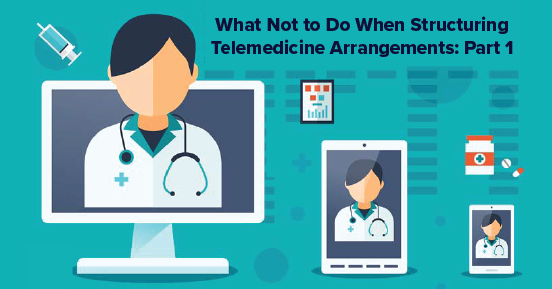Author: Kevin Cassell

The proliferation of telemedicine has opened a new frontier in contracting for physician services. With its increasing feasibility as a patient care option, a wide variety of healthcare providers have turned to telemedicine programs to secure affordable coverage in the face of physician shortages and rising costs. As the number of telemedicine arrangements in the market has continued to climb sharply, so has the need for obtaining reliable opinions of fair market value (FMV) and commercial reasonableness to ensure compliance.
As the industry has evolved in new ways, operators cannot succumb to the temptation of using old compensation models when designing telemedicine arrangements. Although traditional compensation models may be applicable in certain cases, telemedicine arrangements require deep familiarity with the technology, workflow, and service offerings of this growing industry to ensure that providers are compensated appropriately.
Based upon our experience with telemedicine, HealthCare Appraisers has identified common pitfalls to avoid when structuring these arrangements.
DON’T ASSUME THAT TELEMEDICINE COVERAGE IS THE SAME AS CALL COVERAGE
While call coverage arrangements and telemedicine arrangements have some characteristics in common, such as requiring prompt physician consultation, there are several distinctions that could have implications upon FMV compensation and commercial reasonableness, such as:
Response time requirement and scheduling: Traditional on-call arrangements often entail a response time requirement associated with a physician’s telephonic response or presence at the hospital. Depending on the service line, telemedicine service arrangements may require faster or slower response times. For example, a stroke telemedicine program may designate multiple providers to cover numerous facilities concurrently, so that they can respond immediately when contacted, given the need for rapid intervention for patients exhibiting stroke symptoms. Conversely, an inpatient psychiatric telemedicine program dedicated to rounding on patients who are already admitted may only require providers to respond during normal business hours on the following day.
”Burden” of availability: In a traditional hospital on-call arrangement, physicians often respond to call events from their home or office if they are not in the hospital. This coverage is usually provided in addition to the full-time coverage a physician provides for their private practice patients. Due to geographic limitations, such physicians are limited in the number of facilities that can be covered at any given time. In contrast, physicians staffing telemedicine programs often provide concurrent coverage to a large number of facilities, with the expectation that such coverage (including overnight periods) serves as their “full-time” work for the day. Therefore, instead of being required to wake up in the middle of the night under a traditional call model, the individual physician’s schedule under a telemedicine arrangement may be less burdensome. This is because the telemedicine physician’s regular schedule would include coverage of nighttime hours.
Total cost and coverage alternative: From a compliance and financial perspective, understanding the cost differences between different coverage options is a key factor in structuring telemedicine arrangements. Individuals preparing these arrangements must understand the financial benefits or hindrances associated with telemedicine coverage relative to other coverage options, such as call coverage or employment arrangements.
DON’T ASSUME THAT ONE SIZE FITS ALL
The regulatory environment surrounding telemedicine arrangements varies widely from state to state. Medicaid programs may reimburse for no, some, or all telehealth services, depending on multiple factors (e.g., specialty, type of service, delivery of service). Furthermore, many states have enacted “parity” laws that dictate when private insurers must reimburse for telehealth services, and in some cases, the rates at which the reimbursement must be paid. However, such “parity” may only apply to certain telehealth services, or to patients that are located in rural communities. The table below highlights the significant inter-state variability in reimbursement for telehealth services, as summarized by the American Telemedicine Association.[1]
|
State |
Medicaid Reimbursement |
Private Insurer Reimbursement |
|
California |
Reimburses all live video; only reimburses store-and-forward for certain specialties |
Full Parity – private insurers must reimburse for all telehealth services at the comparable in-person rates |
|
Arizona |
Reimburses for remote patient monitoring, store-and-forward, and audio-video for home health services |
Partial Parity – private insurers must reimburse for telehealth services, but limited to eight health services |
|
Connecticut |
No reimbursement for live video, store-and-forward, or other communications |
Full Parity – private insurers must reimburse for all telehealth services at the comparable in-person rates |
|
Utah |
Reimburses for interactive audio-video only; does not reimburse for store-and-forward |
No Parity – private insurers do not have to reimburse for telehealth services |
Additionally, regulations require that physicians maintain active licensure in the state(s) in which their patients are located, even if the care is provided through telemedicine. Certain states, like Maryland, offer licensing reciprocity with bordering states, so that physicians licensed in those states can provide telemedical care of patients located in the state allowing the reciprocity.[2]
The presence or absence of reciprocity may affect FMV compensation for a telemedicine provider. For example, if a state that does not offer reciprocity has a shortage of physicians in the subject specialty, higher compensation benchmarks may be appropriate in valuing the professional component of the telemedicine services.
